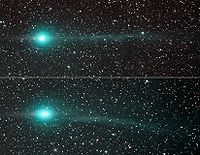
Antitail
Encyclopedia

Astronomy
Astronomy is a natural science that deals with the study of celestial objects and phenomena that originate outside the atmosphere of Earth...
to describe one of the three tails, all pointing in different directions, which may appear to emanate from a comet
Comet
A comet is an icy small Solar System body that, when close enough to the Sun, displays a visible coma and sometimes also a tail. These phenomena are both due to the effects of solar radiation and the solar wind upon the nucleus of the comet...
as it passes close to the Sun
Sun
The Sun is the star at the center of the Solar System. It is almost perfectly spherical and consists of hot plasma interwoven with magnetic fields...
. The antitail appears, when viewed from Earth, as a spike projecting from the comet's coma towards the sun, and thus geometrically opposite to the other tails: the ion tail and the dust tail. The antitail is formed of larger dust particles, which are less affected by the sun's radiation pressure or solar wind, and tend to remain in the comet's orbital plane and eventually form a disc. As the earth passes through the comet's orbital plane, this disc is seen side on, and appears as the characteristic spike. The other side of the disc can sometimes be seen, though it tends to be lost in the dust tail. The antitail is therefore normally visible for a brief interval only when the Earth passes through the comet's orbital plane.
Most comets don't develop sufficiently for an antitail to become visible but notable comet that displayed anti-tails include Comet Arend-Roland
Comet Arend-Roland
Comet Arend–Roland was discovered on November 8, 1956, by Belgian astronomers Sylvain Arend and Georges Roland on photographic plates. As the eighth comet found in 1956, it was named Arend–Roland 1956h after its discoverers. Because it was the third comet to pass through perihelion during 1957, it...
in 1957 and Comet Hale-Bopp
Comet Hale-Bopp
Comet Hale–Bopp was perhaps the most widely observed comet of the 20th century, and one of the brightest seen for many decades...
in 1997.
See also
- The coma and tail at the main Comet article.

